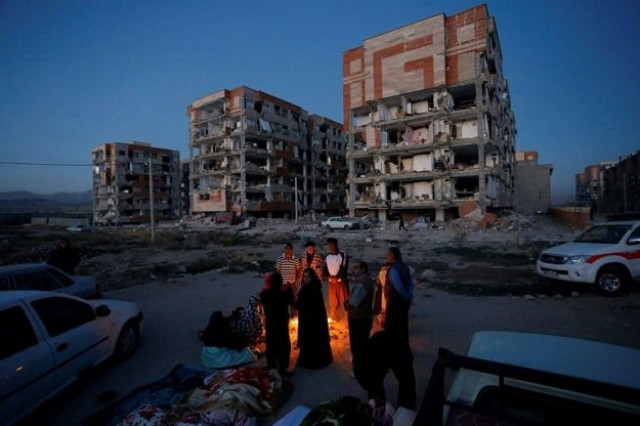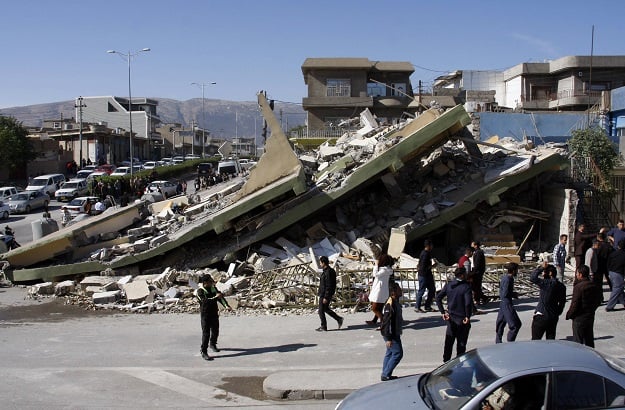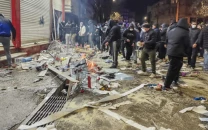Iran quake survivors spend second night in the open air
Death toll in Iran stood at 413 dead, 6,700 injured

Quake survivors huddle by a fire as temperatures drop in Sar-e Pol-e Zahab in western Iran. PHOTO: AFP
People who had fled their homes when the quake rocked the mountainous region spanning Iran's western province of Kermanshah and Iraqi Kurdistan on Sunday evening, braved chilly temperatures as authorities struggled to get aid into the quake zone.
Iran has declared Tuesday a national day of mourning as officials outlined the most pressing priorities and described the levels of destruction in some parts as 'total'.
"People's immediate needs are firstly tents, water and food," said the head of Iran's elite Revolutionary Guards, Major General Mohammad Ali Jafari. "Newly constructed buildings... held up well, but the old houses built with earth were totally destroyed," he told state television during a visit to the affected region.
Iran hunts for survivors as quake kills 400 near Iraq border
The toll in Iran stood at 413 dead and 6,700 injured, while across the border in more sparsely populated areas of Iraq, the health ministry said eight people had died and several hundred were injured. Iraq's Red Crescent put the toll at nine dead.
AFP, like other foreign media organisations, has not been allowed to visit the scene of the disaster.
Officials said they were setting up relief camps for the displaced and that 22,000 tents, 52,000 blankets and tonnes of food and water had been distributed. The official IRNA news agency said 30 Red Crescent teams had been sent to the area.
 A flattened vehicle underneath building rubble is seen following a 7.3-magnitude earthquake at Sarpol-e Zahab in Iran's Kermanshah province. PHOTO: AFP
A flattened vehicle underneath building rubble is seen following a 7.3-magnitude earthquake at Sarpol-e Zahab in Iran's Kermanshah province. PHOTO: AFPHundreds of ambulances and dozens of army helicopters were reported to have joined the rescue effort after Iranian supreme leader Ayatollah Ali Khamenei ordered the government and armed forces to mobilise "all their means".
By late Monday, officials said all the roads in Kermanshah province had been re-opened, although the worst-affected town of Sar-e Pol-e Zahab remained without electricity, said state television.
At least 280 people were killed in the town, home to some 85,000 people. Buildings stood disfigured, their former facades now rubble on crumpled vehicles.
The tremor shook several western Iranian cities including Tabriz and was also felt in southeastern Turkey, an AFP correspondent said. In the town of Diyarbakir, residents were reported to have fled their homes.
 People gather around a levelled building in the mountainous town of Darbandikhan in Iraqi Kurdistan. PHOTO: AFP
People gather around a levelled building in the mountainous town of Darbandikhan in Iraqi Kurdistan. PHOTO: AFPSeveral villages were totally destroyed in Iran's Dalahoo County, the Tasnim news agency reported. Five historical monuments in Kermanshah suffered minor damage, but the UNESCO-listed Behistun inscription from the seventh century BC was not affected, the ISNA agency said.
Nizar Abdullah spent Sunday night with neighbours sifting through the ruins of a two-storey home next door after it crumbled into concrete debris.
"There were eight people inside," the 34-year-old Iraqi Kurd said.
Some family members managed to escape, but "neighbours and rescue workers pulled out the mother and one of the children dead from the rubble".
The quake, which struck at a relatively shallow depth of 23 kilometres, was felt for about 20 seconds in Baghdad, and for longer in other provinces of Iraq, AFP journalists said. It struck along a 1,500-kilometre fault line between the Arabian and Eurasian tectonic plates, which extends through western Iran and northeastern Iraq.
The area sees frequent seismic activity.
Iran ends rescue operations, battles to shelter quake survivors
In 1990, a 7.4-magnitude quake in northern Iran killed 40,000 people, injured 300,000 and left half a million homeless, reducing dozens of towns and nearly 2,000 villages to rubble.
Thirteen years later, a catastrophic quake flattened swathes of the ancient southeastern Iranian city of Bam, killing at least 31,000.
Iran has experienced at least two major quake disasters since, one in 2005 that killed more than 600 and another in 2012 that left some 300 dead.



















COMMENTS
Comments are moderated and generally will be posted if they are on-topic and not abusive.
For more information, please see our Comments FAQ